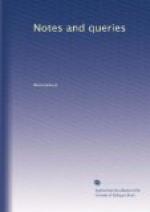16. Soho Square. Mr. Cunningham has not corrected his mistake about Mrs. Cornelys’s house in this square, (see “Notes and Queries,” vol. i., pp. 244, 450.). D’Almaine’s, which Mr. Cunningham confounds with Mrs. Cornelys’s, was at a former period tenanted by the Duke of Argyll; then by the Earl of Bradford; and, at a later time, by the celebrated Onslow, who held his parliamentary levees in the principal drawing-room. The ceilings of the best rooms are adorned with paintings by Rebecca and Angelica Kauffman.
Mr. Cunningham has taken some pains to destroy the Pennant tradition concerning the name of this square, but he has not given us one important piece of information, i.e. that between the years 1674 and 1681, the ground was surveyed by Gregory King, an eminent architect of those days, who projected the square with the adjacent streets. Query, Did it not take the name of King’s Square from the architect? This seems very probable; more especially as the statue of Charles I. was not placed in the square until the beginning of the next century. The centre space was originally occupied by a splendid fountain, (the work of Colley Cibber’s father), an estimate of the “cost and charges” of which is now before me.
Among the eminent inhabitants of this square, not noticed by Mr. Cunningham, were the following:—Lord {228} Berkely, Lord Byron, Lord Grimstone, Lord Howard, Lord Leicester, Sir Thomas Mansel, Lord Morpeth, Lord Nottingham, Lord Peterborough, Lord Pierrepoint, Lord Pigot, Dudley North, the Earl of Dartmouth, the Duchess of Cleveland, the Duchess of Wharton, &c. These names appear in the books of the parish of St. Anne, between the years of 1708 and 1772.
17. Surrey Institution. At one period (about 1825), this building was known as the Blackfriars Rotundo. Here that execrable character, Robert Taylor, who styled himself “the Devil’s Chaplain,” delivered his blasphemous discourses.
18. Opera House. Mr. Cunningham, speaking of the translation of Arsinoe, the first Anglo-Italian opera performed in this country, says: “The translation was made by Thomas Clayton.” This is an error, for Clayton himself says, in his preface: “I was obliged to have an Italian opera translated.” Clayton was the composer of the music.
19. James’s (St.) Chapel, St. James’s Palace. Mr. Cunningham says, “The service is chanted by the boys of the Chapel Royal.” This ought to read, “The service is chaunted by the boys and gentlemen of the Chapel Royal” The musical service of our cathedrals and collegiate establishments cannot be performed without four kinds of voices, treble, alto, tenor, and bass.
20. Bagnigge Wells. Mr. Cunningham makes a strange mistake concerning this once popular place of amusement when he says, “first opened to the public in the year 1767.” A stone, still to be seen, let into the wall over what was formerly the garden entrance, has the following inscription:




